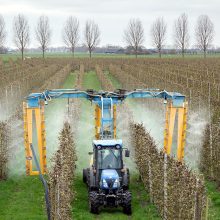By: Dr. David M. Haas and Melissa Perry, ScD
Over 18% of the babies born in Puerto Rico in 2011 were preterm, increasing life-long risks for multiple adverse developmental, reproductive, and chronic disease outcomes. In that same year, an NIH-funded birth cohort study was initiated entitled the Puerto Rico Testsite for Exploring Contamination Threats (PROTECT).
The PROTECT birth cohort included 1,028 babies, 10% of whom were born preterm. Multiple papers have been published by the research team reporting on factors associated with elevated risk of preterm birth.
In a 2019 paper reporting PROTECT study results, the team identified links between socioeconomic factors and preterm births, but no other significant risk factors. The last sentence in the paper’s conclusion section reads:
“Environmental factors including chemical exposures may play an important role in the etiology of adverse birth outcomes but have yet to be explored in Puerto Rico.”
Results of a PROTECT nested case-control study were published on May 19, 2021 in Environmental Health Perspectives . Silver et al (2021) report strong associations between preterm birth and levels of glyphosate (GLY) and AMPA in the urine of pregnant women. Aminomethylphosphonic acid (AMPA) is GLY’s major metabolite and a primary source of dietary exposures following food-crop applications of glyphosate-based herbicides.
The new PROTECT study reports an unexpected finding — GLY and AMPA levels in urine late in pregnancy are more strongly associated with preterm birth than exposures earlier in pregnancy.
A woman’s first pregnancy results in about 40% of new births annually. It is widely accepted that first pregnancies tend to proceed differently than subsequent ones, but little was known previously about the reasons why. This led to the design and funding by the National Institutes of Health of a large prospective birth cohort study called the Nulliparous Pregnancy Outcomes Study: Monitoring Mothers-to-Be (nuMoM2b).
Over 10,000 pregnant women enrolled in nuMoM2b study sites across the continental US between 2012 and 2015 (Haas et al 2015). This cohort has produced a plethora of research findings related to preterm birth, hypertensive disorders, gestational diabetes, as well as the impact of sociodemographic factors, disordered sleep, and others on disparities and pregnancy outcomes.
Like the PROTECT cohort, nuMoM2b identified several associations between socioeconomic and health status and adverse birth outcomes including preterm delivery, but environmental factors and chemical exposures had not been examined previously.
Early in 2021, the Heartland Health Research Alliance (HHRA) began a nested case-control study drawing on the nuMoM2b cohort. Our new study is similar to the nested case control study examining GLY and AMPA carried out by the PROTECT team. We too are examining associations between GLY and AMPA levels in the urine of pregnant women and adverse birth outcomes, including preterm delivery.
In our study, we are paying close attention to the timing of exposures during pregnancy to assess whether our study replicates the unexpected PROTECT finding that exposures later in pregnancy play a larger role in preterm delivery than first trimester exposures.
We have already reached out to the PROTECT team to learn more from their work and build upon the methodological advances in their GLY and AMPA study.
Nested case-control studies can produce important new insights more quickly and at lower cost than launching a new birth cohort. Finding ways to merge the results of comparably designed case-control studies enhances statistical power and can accelerate the search for answers. We hope to develop new collaborations with other study teams that have completed birth cohort studies to find more answers faster to these pressing women and infant health issues .
Ultimately, we want to highlight potential new avenues to reduce the risk of and prevent preterm births. We are focusing our research on regions like the US Heartland where a large percentage of the landscape is sprayed multiple times every year with herbicides to control weeds in agriculture, in backyards, and public spaces.
About the Authors
Dr. David Haas is the Chair of the HHRA Board, a member of the Heartland Study Management Team, and the Director of OGBYN Research at the Indiana University School of Medicine.
Dr. Melissa Perry is a Co-PI of the Heartland Study and Chair of the Department of Environmental and Occupational Health Sciences at George Washington University.
Sources:
Ferguson, K. K., Rosario, Z., McElrath, T. F., Velez Vega, C., Cordero, J. F., Alshawabkeh, A., & Meeker, J. D.; “Demographic risk factors for adverse birth outcomes in Puerto Rico in the PROTECT cohort;” Plos One, 2019, 14(6), e0217770; DOI: 10.1371/journal.pone.0217770.
Haas, D. M., Parker, C. B., Wing, D. A., Parry, S., Grobman, W. A., Mercer, B. M., Simhan, H. N., Hoffman, M. K., Silver, R. M., Wadhwa, P., Iams, J. D., Koch, M. A., Caritis, S. N., Wapner, R. J., Esplin, M. S., Elovitz, M. A., Foroud, T., Peaceman, A. M., Saade, G. R., Willinger, M., Reddy, U. M., & NuMo, M. b study; “A description of the methods of the Nulliparous Pregnancy Outcomes Study: monitoring mothers-to-be (nuMoM2b);” American Journal of Obstetrics & Gynecology, 2015, 212(4), 539 e531-539 e524; DOI: 10.1016/j.ajog.2015.01.019.
Silver, M. K., Fernandez, J., Tang, J., McDade, A., Sabino, J., Rosario, Z., Velez Vega, C., Alshawabkeh, A., Cordero, J. F., & Meeker, J. D.; “Prenatal Exposure to Glyphosate and Its Environmental Degradate, Aminomethylphosphonic Acid (AMPA), and Preterm Birth: A Nested Case-Control Study in the PROTECT Cohort (Puerto Rico);” Environmental Health Perspectives, 2021, 129(5), 57011; DOI: 10.1289/EHP7295.






